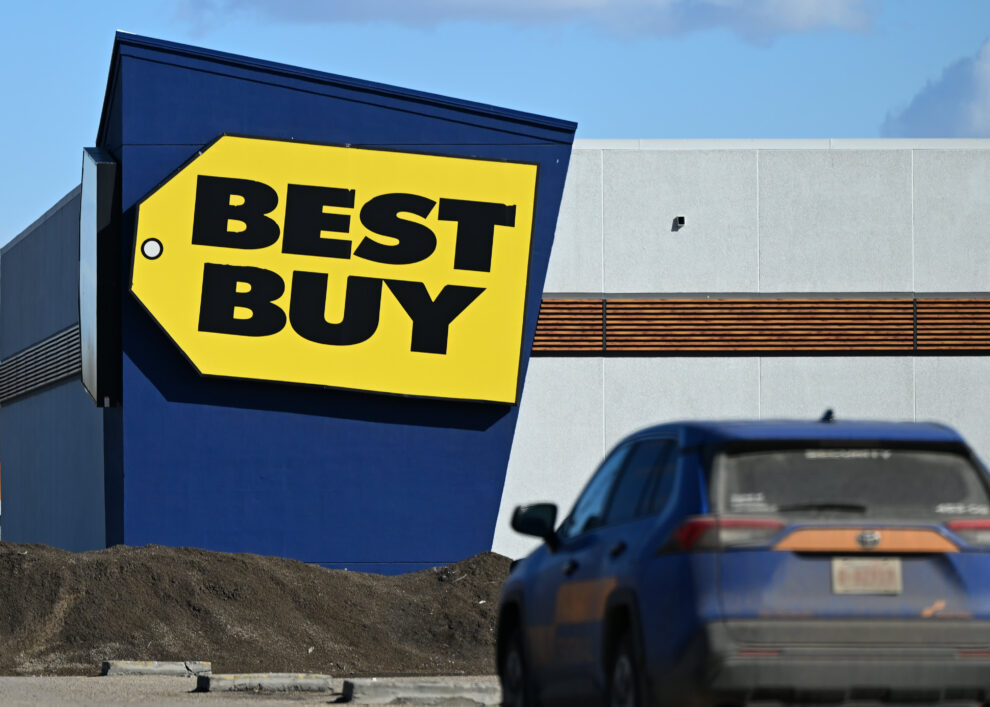
Best Buy surpassed Wall Street revenue and earnings expectations for its most recent quarter on Thursday, but stuck with its full-year forecast, citing tariff uncertainty.
The consumer electronics retailer said it expects revenue of $41.1 billion to $41.9 billion and adjusted earnings per share in a range of $6.15 to $6.30 for its full fiscal year 2026. In May, Best Buy had cut its full-year profit guidance from a prior range of $6.20 to $6.60.
For Best Buy, the middle of its expected full-year revenue range would be roughly flat to its revenue of $41.53 billion in the previous year. Best Buy said it expects full-year comparable sales, a metric that tracks online sales and sales at stores open at least 14 months, to range between a 1% decline and a 1% increase.
On the company’s earnings call, CEO Corie Barry said the retailer is “increasingly confident about our plans for the back half of the year.” She said the company is “trending toward the higher end of our sales range.”
Yet she said, “given the uncertainty of potential tariff impacts in the back half, both on consumers overall as well as our business, we feel it is prudent to maintain the annual guidance we provided last quarter.”
Best Buy’s full-year guidance reflects that some shoppers could hold off on purchases in the third quarter, Chief Financial Officer Matt Bilunas said. He said the retailer could see a slowdown in the business in October “as people are waiting for those holiday deals to come.”
Shares of Best Buy rose about 1% in premarket trading.
Here’s how the retailer did for the three-month period that ended August 2 compared with what Wall Street was expecting, according to a survey of analysts by LSEG:
- Earnings per share: $1.28 adjusted vs. $1.21 expected
- Revenue: $9.44 billion vs. $9.24 billion expected
For Best Buy, a challenging trifecta of factors have complicated the retailer’s outlook. Customers have bought fewer kitchen appliances as they put off home purchases and projects because of higher interest rates. Some have hesitated to splurge on pricier items because of tariff-related uncertainty or held out on tech replacements as they wait for new or eye-catching items. The company’s annual sales have declined for the past three years.
To spur growth, Best Buy launched a third-party marketplace earlier this month to offer shoppers a wider selection of consumer electronics, accessories and more. On the marketplace, sellers who apply for the platform can list their own brands and items on Best Buy’s website and app.
The company already increased prices on some items because of tariff-related higher costs, Barry said on a mid-May call with reporters. She did not specify which items now cost more and described price increases as “the very last resort.”
Tariffs did not have a material impact on fiscal second-quarter financial results, Barry said on the company’s earnings call Thursday.
Barry said that shopping patterns at Best Buy have not changed from previous quarters. She said customers are “resilient, but deal-focused” and have been attracted to the company’s sales events like the one it held in July.
“In the current environment, customers continue to be thoughtful about big ticket purchases and are willing to spend on high price point products when they need to, or when there is technology innovation,” she said.
Best Buy’s net income for the fiscal second quarter of 2026 fell to $186 million, or 87 cents per share, from $291 million, or $1.34 per share, in the year-ago quarter. Adjusting for one-time items, including restructuring charges, Best Buy reported earnings per share of $1.28.
Revenue increased from $9.29 billion in the year-ago quarter.
Comparable sales rose 1.6% in the fiscal second quarter compared to the year-ago period. That marked the company’s highest growth in three years, Barry said on the company’s earnings call.
In the U.S., comparable sales increased 1.1%, as customers bought mobile phones, video gaming equipment and items from its computing category. However, those sales trends were partially offset by weaker sales of appliances, home theaters, tablets and drones, the company said.
Gaming in particular had stronger-than-expected sales in the quarter, thanks to the release of the Nintendo Switch 2, Barry said. The retailer capitalized on the highly anticipated launch by offering a way for customers to pre-order and opening stores at midnight when the gaming console dropped on June 5, so customers could line up and get it right away.
Best Buy online sales in the U.S. rose 5.1% year over year and accounted for about a third of Best Buy’s total U.S. revenue in the quarter.
This is breaking news. Please check back for updates.





